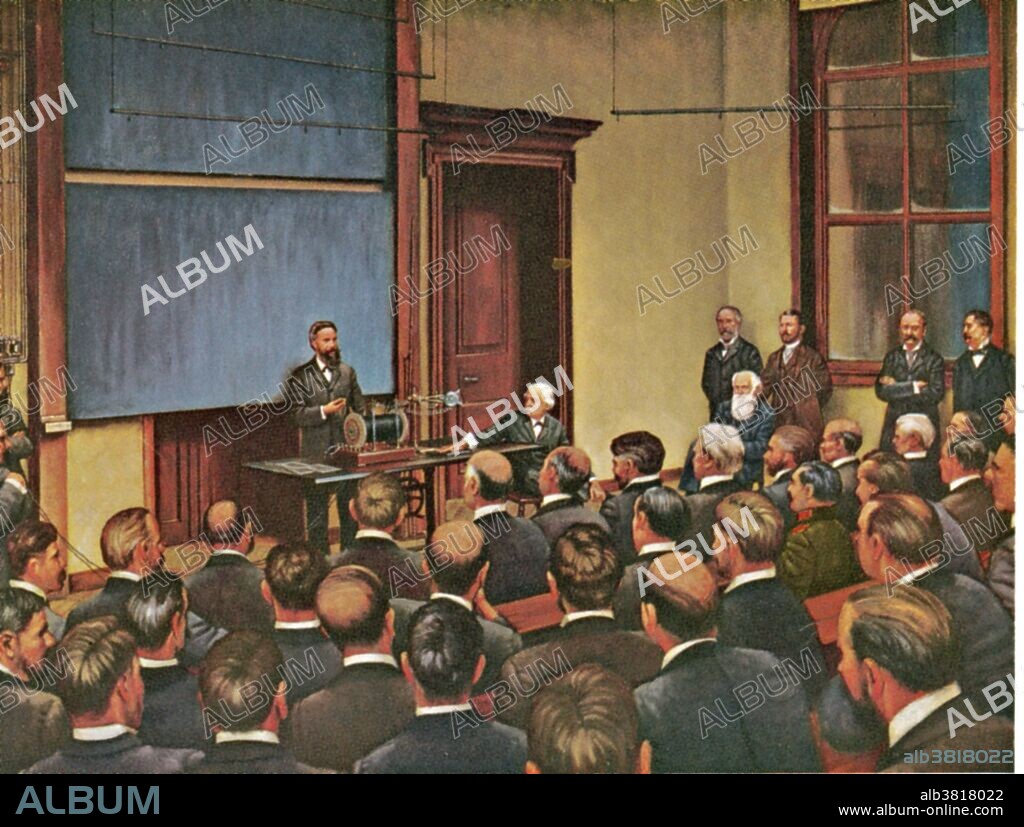alb3818022
Wilhelm Roentgen, First Demonstration of X-Rays, 1896

|
Add to another lightbox |
|
Add to another lightbox |



Buy this image.
Select the use:

Title:
Wilhelm Roentgen, First Demonstration of X-Rays, 1896
Caption:
January 23, 1896, first public demonstration of Wilhem Conrad Roentgen's newly discovered x-rays. He took an x-ray of the hand of Professor Albert von Kolliker which lead to a lively discussion about the possible medical applications of this discovery.Wilhelm Conrad Roentgen (1845-1923), German experimental physicist and discoverer of X-rays. While using a discharge tube (in which an electric discharge is passed through a gas at low pressure) in a darkened room, Roentgen noticed that a card coated with barium platinocyanide glowed when the tube was switched on. The effect was not blocked by an intervening wall, or even a thin sheet of metal. Roentgen termed this newly discovered phenomenon X-ray radiation, and suggested that it consisted of electromagnetic rays with a shorter wavelength than light. He was awarded the first Nobel Prize for Physics in 1901.
Credit:
Album / Science Source / New York Public Library
Releases:
Model: No - Property: No
Rights questions?
Rights questions?
Image size:
3924 x 2965 px | 33.3 MB
Print size:
33.2 x 25.1 cm | 13.1 x 9.9 in (300 dpi)
Keywords:
1845 • 1896 • 1901 • 1923 • 19TH CENTURY • 20 XX TWENTIETH CENTURY • 20TH CENTURY • 20TH • 23RD • 23TH • BARIUM PLATINOCYANIDE • BARIUM • CELEBRITIES • CELEBRITY • DETECTED • DETECTION • DISCOVERED • DISCOVERY • ELECTROMAGNETIC RADIATION • ELECTROMAGNETIC RAYS • ELECTROMAGNETIC • EUROPEA • EUROPEAN • EUROPEANS • EXPERIENCE • EXPERIMENT CONSTRUCTION = SETTING UP EXPERIMENT • EXPERIMENT CONSTRUCTION • EXPERIMENT • FAMOUS PEOPLE • FAMOUS • FIGURE • FIRST NOBEL PRIZE • FIRST • GERMAN • GERMANS • HISTORIC • HISTORICAL • HISTORY • IMPORTANT • JANUARY • MALE • MAN • MEN • NOBEL LAUREATE • NOBEL PRIZE LAUREATE • NOBEL PRIZE RECIPIENT • NOBEL PRIZE WINNER • NOBEL PRIZE • NOBEL RECIPIENT • NOBEL WINNER • NOBEL • NOBELIST • NOTABLE • PEOPLE • PERSON • PERSONALITIES • PERSONALITY • PHYSICIST • PHYSICS • PLATINOCYANIDE • PRODUCED • PROFESSOR • PUBLIC DEMONSTRATION • ROENTGEN RAYS • ROENTGEN • RONTGEN RAYS • RONTGEN • RöNTGEN • SAVANT • SCIENCE • SCIENTIFIC • SCIENTIST • SETTING UP EXPERIMENT • SHORT WAVE ELECTROMAGNETIC RAYS • SHORT WAVE • TWENTIETH CENTURY • W. C. ROENTGEN • W. C. RONTGEN • W. K. ROENTGEN • W. K. RONTGEN • W. ROENTGEN • W. RONTGEN RONTGEN • WAVELENGTH • WELL-KNOWN • WILHELM C. ROENTGEN • WILHELM C. RONTGEN • WILHELM CONRAD ROENTGEN • WILHELM CONRAD RONTGEN • WILHELM K. ROENTGEN • WILHELM K. RONTGEN • WILHELM KONRAD ROENTGEN • WILHELM KONRAD RONTGEN • WILHELM RONTGEN • WURZBURG • X RAY • X-RAY • XRAY
 Pinterest
Pinterest Twitter
Twitter Facebook
Facebook Copy link
Copy link Email
Email
